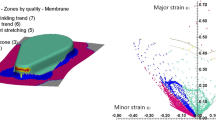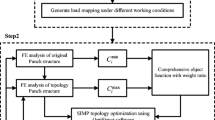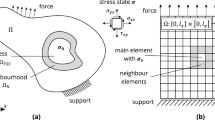Abstract
Automotive manufacturers have been struggling with the big challenge of how to produce dimensionally acceptable stamped parts with minimal material cost. The thin nature of the sheet metal has always complicated the process and made the dimensional quality objectives difficult to achieve. The final layout quality is impacted by several fabrication flaws such as springback and failure. A possible approach to circumvent these unwanted process drawbacks consists in optimizing the process parameters with innovative methods. The aim of this paper is to introduce an efficient methodology to deal with complex, computationally expensive multicriteria optimization problems. Our approach is based on the combination of methods to capture Pareto Front, suitable surrogates (to save computational costs) and global optimizers. To illustrate the efficiency, we consider the stamping of an industrial workpiece as test-case. Our approach is applied to springback and failure criteria. To optimize these two criteria, a global approach was chosen. It is the Simulated Annealing algorithm hybridized with the Simultaneous Perturbation Stochastic Approximation in order to gain in time and in precision. The multicriteria concern amounts to the capture of the Pareto Front associated to the two criteria. Indeed, springback and failure are two conflicting criteria. Normal Boundary Intersection and Normalized Normal Constrained Method are considered for generating a set of Pareto-optimal solutions with the characteristic of uniform distribution of front points. The computational results are compared to those obtained with the well-known Non-dominated Sorting Genetic Algorithm II. The results show that our proposed approach is efficient to deal with the multicriteria parametric and shape optimization of highly non-linear mechanical systems.






























Similar content being viewed by others
References
Achatz S (2003) Higher order sparse grid methods for elliptic partial differential equations with variable coefficients. Comput 71(1):1–15
Balder R, Rüde U, Schneider S et al (1994) Sparse grid and extrapolation methods for parabolic problems. In: Proceeding of international conference on computational methods in water ressources. Heidelberg Kluwer Academic, Dordrecht, pp 1383–1392
Bungartz HJ, Dirnstorfer S (2003) Multivariate quadrature on adaptive sparse grids. Comput 71(1):89–114
Bungartz H, Huber W (1995) First experiments with turbulence simulation on workstation networks using sparse grid methods. Comput Fluid Dyn Parallel Syst Notes Numer Fluid Mech (NNFM). Vieweg+ Teubner Verlag 50:36–48
Cerny V, Gelatt CD, Vecchi MP (1985) Thermodynamical approach to the traveling salesman problem: an efficient simulation algorithm. J Optim Theory Appl 45:41–51
Col A (2010) L’emboutissage des aciers. Dunod, Paris
Das I, Dennis JE (1998) Normal-boundary intersection, a new method for generating the pareto surface in nonlinear multicriteria optimization problems. SIAM J Optim 8(3):631–657
Deb K (1999) Multiobjective genetic algorithms: Problem difficulties and construction of test problems. Evol Comput 8(2):205–230
Deb K, Partap A, Agarwal S, Meyarivan T (2002) A Fast and elitist multiobjective genetic algorithm: NSGA-II. IEEE Trans Evol Comput 6(2):182–197
De Jong KA (1975) An analysis of the behavior of a class of genetic adaptive systems. University of Michigan, Doctoral Dissertation
Dunne F, Petrinic N (2005) Introduction to computational plasticity. Oxford University Press Inc, New York
Fabian V (1971) Stochastic approximation. Optimizing Methods in Statistics. Academic Press, New York, pp 439–470
Fonseca CM, Fleming PJ (1993) In Proceedings of the Fifth International Conference on Genetic Algorithms, San Mateo, CA: Morgan Kauffman. In: Forrest S (ed) Genetic algorithms for multiobjective optimization: Formulation, discussion and generalization, pp 416–423
Fonseca CM, Fleming PJ, Voigt H-M, Ebeling W, Rechenberg I, Schwefel H-P (1996) On the performance assessment and comparaison of stochastic multiobjective optimizers In parallel problems solving from nature IV, vol 1141. Springer, Berlin, Germany, pp 584–593
Fonseca CM, Fleming PJ (1998a) Multiobjective optimization and multiple constraint handling with evolutionary algorithms - Part I: A unified formulation. IEEE Trans Syst Man, Cybern A 28:26–37
Fonseca CM, Fleming PJ (1998b) Multiobjective optimization and multiple constraint handling with evolutionary algorithms - Part II: Application exemple. IEEE Trans Syst Man Cybern A 28:38–47
Garcke J, Griebel M (2002) Classification with sparse grids using simplicial basis functions. Intell data Anal 6(6):483–502
Hill R (1948) A theory of the yielding and plastic flow of anisotropic metals. Proc Roy Soc London 193:281–297
Kirkpatrick S, Gelatt CD, Vecchi MP (1983) Optimization by simulated annealing. Sci 220:671–680
Klimke A, Wohlmuth B (2005) Algorithm 847: Spinterp: piecewise multilinear hierarchical sparse grid interpolation in MATLAB. ACM Transactions on Mathematical Software (TOMS) 31(4):561–579
Klimke A (2007) Sparse grid interpolation toolboxusers guide. IANS report 17
Kursawe F (1990) In Parallel Problems Solving from Nature. In: Schwefel H-P, Männer R (eds) A variant of evolution strategies for vector optimization, vol 496. Springer, Berlin, Germany, pp 193–197
Kushner HJ, Yin GG (1997) Stochastic approximation algorithms and applications. Springer, New York
Llewellyn DT, Hudd RC (1998) Steels: metallurgy and applications. Butterworth-Heinemann, Oxford
Marciniak Z, Duncan JL, Hu SJ (2002) Mechanics of sheet metal forming. Butterworth-Heinemann, Oxford
Marsden JE, Wiggins S, Hughes TJR, Sirovich L (1998) Computational Inelasticity. Springer, New York
Messac A, Ismail-Yahaya A, Mattson CA (2003) The normalized normal constraint method for generating the pareto frontier. Struc Multidisc Optim 25(2):86–98
Metropolis N, Rosenbluth AW, Rosenbluth MN, Teller AH, Teller E, Teller (1953) Equation of state calculations by fast computing machines. J Chem Phys 21:1087–1090
Schaffer JD (1987) In Proceedings of the first international conference on genetic algorithms. In: Grefensttete JJ (ed) Multiple objective with vector evaluated genetic algorithms. Lawrence Erlbaum, Hillsdale, NJ, pp 93–100
Smolyak SA (1963) Quadrature and interpolation formulas for tensor products of certain classes of functions. Dokl. Akad. Nauk SSSR, 148:10421043, Russian, Engl. Transl.: Soviet Math. Dokl. 4, 240243
Spall JC (1998a) Implementation of the Simultaneous Perturbation Algorithm for Stochastic Optimization. IEEE Trans Aerosp Electron Syst 34(3):817–823
Spall JC (1998b) An overview of the simultaneous perturbation method for efficient optimization. Johns Hopkins APL Tech Digest 19(4):482–492
Spall JC (1998c) Introduction to stochastic search and optimization: estimation, simulation, and control. Jhon Wiley & Sons, Inc., Hoboken, New Jersey
Van Veldhuizen D (1999) Multiobjective evolutionary algorithms: classifications, analyses and new innovations, doctoral dissertation air force inst. technol., Dayton, OH, Tech. Rep. AFIT/DS/ENG/ 99-01.
Zitzler E, Thiele L (1998) Multiobjective optimization using evolutionary algorithms - A comparative case study. In: Eiben AE, Bäck T, Schoenauer M, Schwefel H-P (eds) In Parallel problems solving from nature, V, vol 1498. Springer, Berlin, Germany, pp 292–301
Zitzler E (1999) Evolutionary algorithms for multiobjective optimization: methods and applications, doctoral dissertation ETH 13398, Swiss federal institue of technology (ETH). Zurich, Switzerland
Zitzler E, Deb K, Thiele L (2000) Comparaison of multiobjective evolutionary algorithms: empirical results. Evol Comput 8(2):173–195
Acknowledgements
The present work was achieved within the framework of the OASIS Consortium, funded by the French FUI grant id. 1004009Z.
Author information
Authors and Affiliations
Corresponding author
Rights and permissions
About this article
Cite this article
Oujebbour, FZ., Habbal, A. & Ellaia, R. Optimization of stamping process parameters to predict and reduce springback and failure criterion. Struct Multidisc Optim 51, 495–514 (2015). https://doi.org/10.1007/s00158-014-1138-3
Received:
Revised:
Accepted:
Published:
Issue Date:
DOI: https://doi.org/10.1007/s00158-014-1138-3




